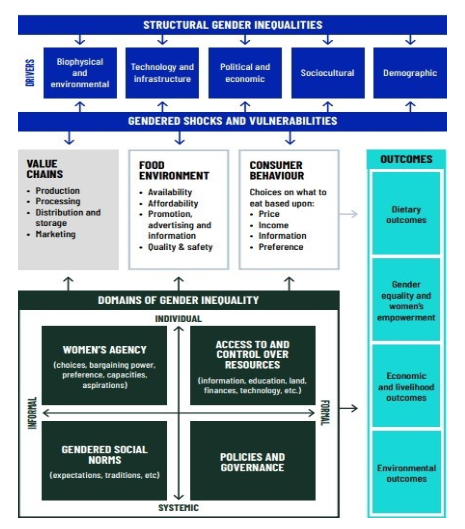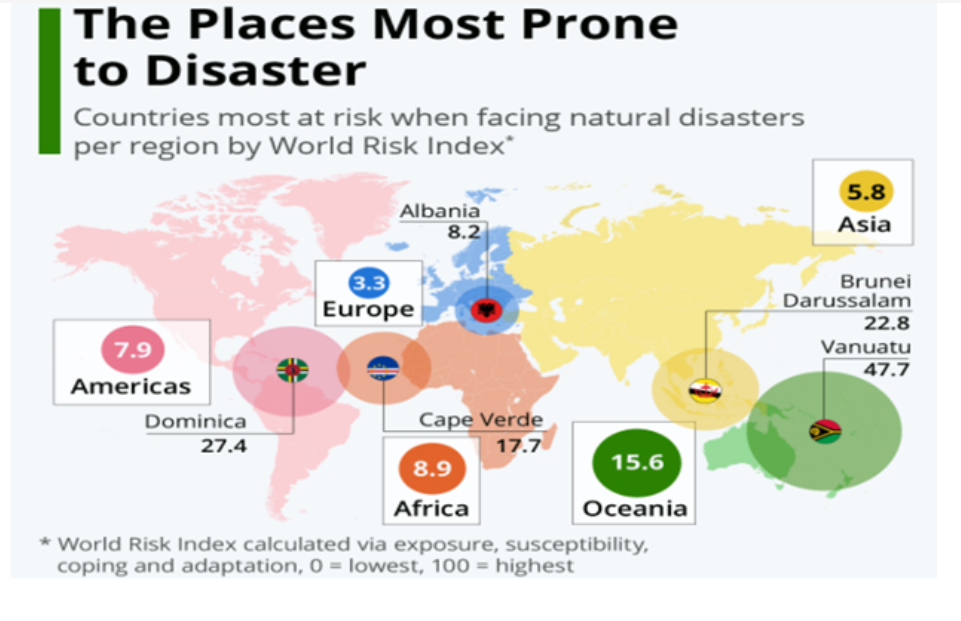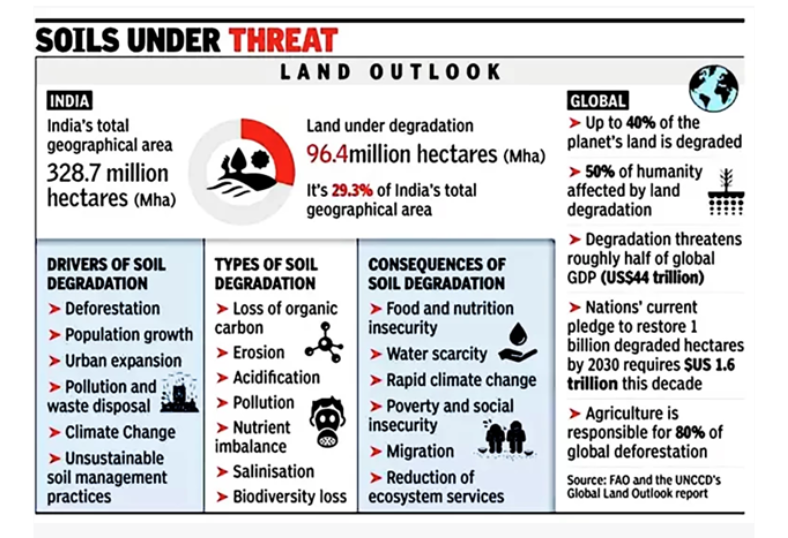10 Dec to 24 Dec, 2023
CLIMATE CHANGE , FOOD SECURITY AND CLIMATE SMART AGRICULTURE
Why In news: According to the Global Food Policy Report (2022), climate change may push many Indians towards hunger by 2030 due to a decline in agricultural production and disruption in the food supply chain.
Background:
- Global food insecurity had already been rising, due in large part to climate phenomena.
- As temperatures rise, the yields of food and cash crops in South Asia are expected to decline, putting pressure on food security in the region.
- India, home to 1.4 billion people, is ranked 107 out of 116 countries in the Global Hunger Index, indicating a serious problem. It is projected that a 2.5 to 4.9 degrees Celsius increase in temperature across the country could lead to a decrease of 41%-52% in the wheat yield, and 32%-40% in rice.
- Effects on the nutritional quality of grains- an increase in carbon dioxide (CO2) in the atmosphere will have an adverse effect on nutritional quality. A decline in the nutritional quality of grains could exacerbate “hidden hunger”, a form of under-nutrition.
- At the same time, the way that food is often produced today is a big part of the problem. It is estimated that the global food system is responsible for about a third of greenhouse gas emissions— second only to the energy sector; it is the number one source of methane and biodiversity loss.
HOW CLIMATE CHANGE IS DISRUPTING FOOD PRODUCTIVITY AND CAUSING FOOD INSECURITY AROUND THE WORLD
- Climate change impact on agro-ecosystems:
- Impact on food availability (productivity):
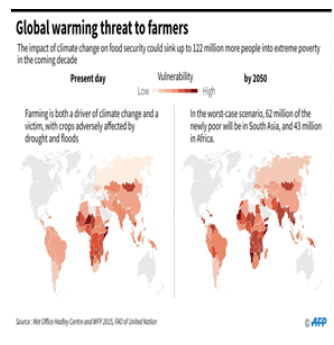
-
-
- Direct impacts include effects caused by a modification of physical characteristics such as temperature levels and rainfall distribution on agricultural production systems.
- Indirect effects are those that affect production through changes on other species such as pollinators, pests, disease vectors and invasive species. These indirect effects can play a major role. They are much more difficult to assess and project given the high number of interacting parameters and links, many of which are still unknown.
- Rising global temperature will affect wheat production in all producing countries as wheat has a relatively low optimum temperature. For tropical climate systems, extreme heat limits the length of the growing season. For example, in India, the Indo-Gangetic Plains could become significantly heat stressed by 2050s potentially causing losses of 50 per cent of its wheat-growing area.
- Climate change affects capture fisheries and the development of aquaculture in marine and freshwater environments : Impacts occur as a result of both gradual atmospheric warming and associated physical (sea and inland water surface temperature, ocean circulation, waves and storm systems) and chemical changes (salinity content, oxygen concentration and acidification) of the aquatic environment.
- Increased occurrence of coral reef bleaching has been observed, threatening habitats of one out of four marine species. Various fish species are already migrating pole ward, resulting in the rapid “tropicalization” of mid- and high-latitude systems.
- A large scale redistribution of global marine fish catch potential is forecast, with a decrease of up to 40 percent in the tropics, and an increase of 30 to 70 percent in high-latitude regions.
-

- Climate change generates considerable uncertainty about future water availability in many regions: It will affect precipitation, runoff and snow/ice melt, with effects on hydrological systems, water quality and water temperature, as well as on groundwater recharge.
- An increase in temperature will trigger increased demand for water for evapo-transpiration by crops and natural vegetation and will lead to more rapid depletion of soil moisture.
Case study: India’s climate is projected to increase by 2–4°C by 2050 with some marginal changes in monsoon rain in monsoon months and large changes in rainfall during non-monsoon months. An increase of 2°C in temperature could decrease rice yields by
about 0.75 tonnes per hectare in the high yielding areas. Impacts on production translate into economic and social consequences, affecting food security: Climate change affects food security in all its dimensions: access, availability, utilization and stability.
- Climate change affects food production, and thus food availability : Climate change will impact the livelihoods and income of small-scale food producers and also, through food price increases and volatility, the livelihoods of poor net food buyers, restricting access to food.
- Climate change can have a variety of impacts on the quality of drinking water, which is key to the good absorption of nutrients.
- Climate change has been found to have an impact on food safety, particularly on incidence and prevalence of food-borne diseases.
- Increased climate variability, increased frequency and intensity of extreme events as well as slow ongoing changes will affect the stability of food supply, access and utilization.
- Net effects of climate change on food security depend on vulnerabilities of affected systems.
- Way forward to ensure availability of food
- Climate smart agriculture: Agricultural sectors must become climate-smart to successfully tackle current food security and climate change challenges. Agriculture, including forestry and fisheries, is crucial for food security and rural incomes as well as other essential products, such as energy, fiber, feed and a range of ecosystem services. Climate-smart agriculture is a pathway towards development and food security built on three pillars:
- Increasing productivity and incomes,
- Enhancing resilience of livelihoods and ecosystems and
- Reducing and removing greenhouse gas emissions from the atmosphere.
Climate-smart agriculture contributes to a cross-cutting range of development goals. There are many opportunities for capturing synergies between the pillars of climate-smart agriculture, but also many situations where trade-offs are inevitable
- Agro-climatic planning: Switch to less-thirsty crops for dry regions. For example, rice farmers could switch to crops that require less water such as maize or legumes.
- Invest in food processing and storage: Importing countries can develop local food processing and storage industries to increase the shelf life and safety standards of food, as food spoilage becomes an issue under warmer and more volatile weather conditions.
- Diversify sources of food based on emerging climatic patterns: Policies encouraging diversification should consider similar climatic zones. Countries within the same climate and geographical region are likely to face the same climate impacts. The concentration of imports from a particular climatic region will not reduce the risks associated with climate change.
- The 2021 United Nations Food Systems Summit called on the global community to focus on global efforts and contributions to transform food systems. To meet the challenges of growing demand and food insecurity, we need to improve productivity through sustainable agriculture and farmer incomes. Digital transformation is key to driving innovation and adaptation in the agri-food sector. As well as making commitments—at all levels, including local, state, and national—to strengthening the resilience and sustainability of food systems, policymakers should invest in strategies and solutions to mitigate the effects of climate change on food systems.
Where to use it ?
Paper1 : Climatology (Global climatic change), Economic geography (World agriculture, Food and nutrition problems; Food security)
Paper2: Agriculture, contemporary issues
INTERNATIONAL YEAR OF MILLETS 2023 : INDIA CAN LEAD THE WAY
Why in the news : The year 2023 was declared as International Year of Millets (IYM) by United Nations
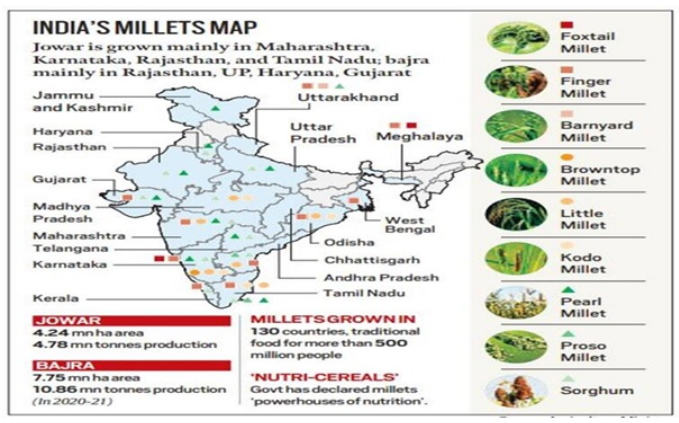
- India, the largest producer of nutri-cereals, has initiated steps to boost exports. India accounts for an estimated share of around 41 percent of global millets production.
- India produces more than 170 lakh tonnes of millet, which is 80 per cent of Asia’s and 20 per cent of global production.
- Millets have been reduced to “orphan crops” over the years, planted largely in marginal areas prone to moisture stress.
- Between 2003-04 and 2021-22, India’s millet output has actually fallen from 21.32 mt to 15.92 mt.
- Not only has the consumption of millets declined, but the area under production has been replaced with commercial crops, oilseeds, pulses and maize. This has resulted in changes in dietary patterns with preferential consumption towards fine calorie-rich cereals.
Millets as Smart-Foods: Significance and Benefits:
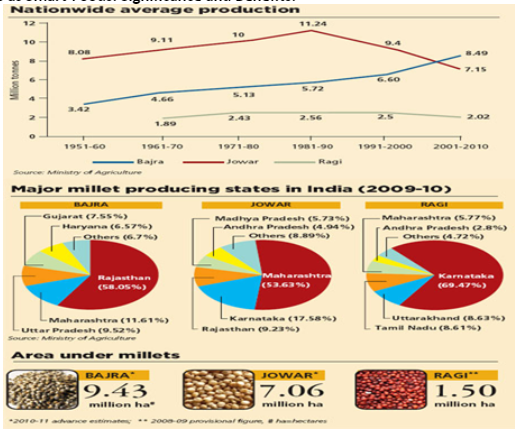
- Health and Nutritionally Rich: Millets are nutritionally superior to wheat and rice owing to their higher levels of protein with a more balanced amino acid profile. Similarly, the dietary fiber content of millet is also higher compared to some of the staple cereals. Millets also contain various phytochemicals which exert therapeutic properties owing to their anti-inflammatory and anti-oxidative properties. The nutritionally superior traits — which significantly address the problem of “hidden hunger” arising from the consumption of energy-dense but micronutrients-deficient foods — are present in other millets too.
- Climate Resilient: Millets are the backbone for dry land agriculture. They are hardy, resilient crops that have a low carbon and water footprint, can withstand high temperatures, grow on poor soils with little or no external inputs and are thus termed as the ‘miracle grains’ or ‘crops of the future’. In times of climate change, they are the most secure crops to small farmers as they are the hardiest, most resilient and climate adaptable crops in harsh and drought environments.
- Ecologically Sustainable: Millet production is not dependent on the use of chemical fertilizers. These crops do not attract pests, and a majority of the millets are not affected by storage pests. Thus, the use of pesticides is also not mandated.
Why is increasing the consumption and production of millets important to India?
- Millets are primarily grown during the kharif season in rainfed areas as these crops require less water and agricultural inputs than other cereals. It has great potential to generate livelihoods, increase farmers’ income and ensure food and nutritional security.
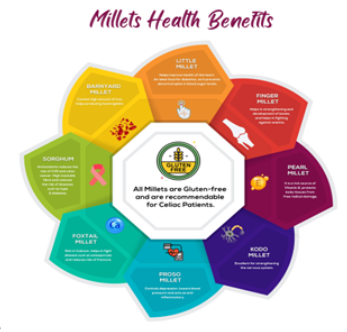
- Will help double farm incomes and encourage farm diversification is to make millet production attractive by introducing millet cultivation in areas where farmers’ distress is visible. For instance, the cotton dependency of Vidarbha's farmers and economy is well-known, especially in the arid zones. The region in Maharashtra is also known as the farmer suicide capital.
- Will help tackle distress linked to feminisation of agriculture associated with rural to urban migration of male counterparts.
- Millet can solve Indian malnutrition problems: India still has one of the worst rates of child malnutrition in the world. Millets, being super foods, are high in both macro-nutrients, like proteins and fats, and micro-nutrients, like iron and calcium and can guard us against many vitamin and mineral deficiencies. Example: inclusion of millets in Mid-day meal program.
Initiatives taken by India:
- In view of the nutritional value of the millets, the Government has notified millets as Nutri-cereals in 2018.
- The Government, under the Sub Mission on National Food Security Mission (NFSM) -Nutri-cereals, is creating awareness among farmers for Nutri Cereals (Millets) such as ragi, sorghum, bajra and small millets through demonstration and training.
- National Millets Mission (NMM): launched in 2007 to promote the production and consumption of millets.
- The Government is popularizing Nutri-cereals through Research & Development support.
- Price Support Scheme (PSS): Provides financial assistance to farmers for the cultivation of millets.
- The government has introduced millets in the Public Distribution System to make it accessible and affordable to the masses.
- Union Budget 2022-23 highlighted that support would be provided for post-harvest value addition, enhancing domestic consumption, and for branding millet products nationally and internationally.
- A major initiative was taken by the Union Ministry of Agriculture and Farmers Welfare by organizing a 'Special Millets Lunch' for MPs in the Parliament in 2022.
- By declaring 2023 as ‘The International Year of Millets,’ the UN General Assembly has set the tone for increasing the area of cultivation of millet across the world. India, which is the world’s largest producer of millet, is taking wide-ranging steps to implement the benefits of this opportunity
Where to use ?
Paper1 : Climatology (Global climatic change), Economic geography (World agriculture, Food and nutrition problems; Food security)
Paper2 : Agriculture, contemporary issues
EL NINO FUELLED NORTH EAST MONSOON CAUSED THE DELUGE IN SOUTH TAMIL NADU
Why in news : Many parts of southern Tamil Nadu got flooded due to Cyclone Michaung in early December. The cause for this is an active Northeast monsoon (NEM) fuelled by the El Nino phenomenon, which is peaking right now.
About :
- El Nino, characterized by warmer-than-normal temperatures in the central and eastern Pacific Ocean, is a phase of the El Nino Southern Oscillation Phenomenon (ENSO).
- This phase tends to augment rainfall extremes, specifically during the Northeast monsoon period.
Impact of El Nino on Rainfall Extremes
- Studies indicate that extreme rainfall occurrences during the Northeast monsoon in regions of southern Tamil Nadu are notably more frequent than during the Southwest monsoon season.
- The recent heavy rainfall is a reflection of this pattern, with five districts experiencing significant downpours, surpassing normal rainfall levels by staggering percentages.
- Tirunelveli received 363.6 mm of rainfall, an astonishing 5,094% higher than the usual amount.
- Thoothukudi encountered 343.6 mm of rain, exceeding the normal by 7,059%.
- Other affected districts include Tenkasi, Virudhunagar, and Kanyakumari, each experiencing substantial rainfall exceeding the expected averages.
Meteorological Factors Contributing to Extreme Rainfall
- Experts emphasize the contribution of the El Nino phenomenon in intensifying the Northeast monsoon, thereby creating conducive conditions for extreme rainfall events.
- Factors contributing to the deluge include:
- Cyclonic Circulations:
- These atmospheric whirls in upper layers induce low-pressure areas, leading to rainfall.
- The presence of cyclonic circulations, particularly near Kanyakumari, facilitated strong upper-level divergence.
- This resulted in significant low-level convergence of moisture-laden winds towards south Tamil Nadu.
- Upper-Level Divergence and Low-Level Convergence:
- The spreading out of air in the upper atmosphere causes air below to rise, leading to low-level convergence.
- This process brings moisture-laden winds, fostering extreme rainfall events.
- Influence of Cyclonic Systems:
- After the impact of Cyclone Michaung, a diffuse cyclonic system near the south Tamil Nadu coast further intensified northeast winds, creating wind and wave convergence over the region, especially around the gap between Sri Lanka and Tamil Nadu (Palk Bay & Gulf of Mannar).
- Cyclonic Circulations:
Previous Observations and Weather Patterns
- Historically, research suggests that extreme rainfall during the Northeast monsoon (December-February) is more prevalent in the southern regions of Tamil Nadu and Sri Lanka compared to the Southwest monsoon (June-September).
- Studies analyzing 30 different weather patterns have identified specific climate variability, with certain patterns significantly associated with extreme rainfall occurrences in autumn and winter around Sri Lanka and south Tamil Nadu.
EL-NINO:
- El Niño is characterized by unusually warm ocean temperatures in the Equatorial Pacific, as opposed to La Niña, which is characterized by unusually cold ocean temperatures in the Equatorial Pacific.
- El Niño is an oscillation of the ocean-atmosphere system in the tropical Pacific having important consequences for weather around the globe.
- Among these consequences are increased rainfall across the southern tier of the US and in Peru, which has caused destructive flooding, and drought in the West Pacific, sometimes associated with devastating brush fires in Australia.
- Observations of conditions in the tropical Pacific are considered essential for the prediction of short term (a few months to 1 year) climate variations.
Implications and Conclusion
- The current deluge over Thoothukudi and Tirunelveli aligns with one of these identified patterns.
- The active pattern during the NEM season strengthens the monsoon, potentially enhancing rainfall over coastal Tamil Nadu and Sri Lanka.
- In essence, the convergence of various meteorological factors, including El Nino’s influence on the Northeast monsoon, cyclonic circulations, upper-level divergence, and low-level convergence, has contributed to the recent extreme rainfall events in south Tamil Nadu.
- Understanding these complex interactions is crucial for predicting and mitigating the impacts of such extreme weather occurrences in the future.
Where to use ?
Paper 2 : Monsoons
Astro Tourism
Astro Tourism: It is a type of tourism that involves visiting astronomical facilities, such as observatories, and observing astronomical phenomena. It also combines a broader sense of ecotourism, where the visitor experience is about interacting with nature.
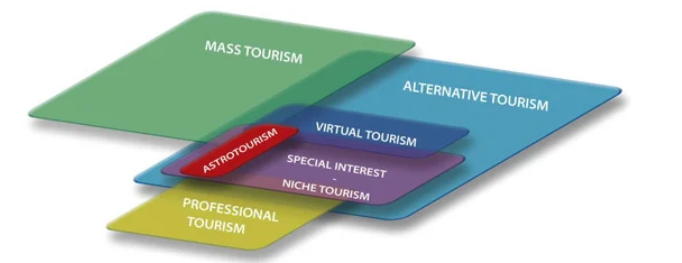
Tropicalisation
Tropicalisation : It refers to the process by which temperate ecosystems are transformed due to the movement of tropical organisms towards higher latitudes. This transformation occurs as a response to rising ocean temperatures. As ocean temperatures rise, extreme winter cold events in North America are decreasing. This leads to the poleward expansion of tropical organisms, sometimes displacing temperate organisms.
Cape and trade system
Cape and trade system: Cap and trade, also known as carbon trading, is a market-based policy that limits emissions from a group of emitters. It provides economic incentives to reduce greenhouse gas emissions, primarily carbon dioxide. Cap and trade lets the market find the cheapest way to cut emissions.

Transitional fuels:
Transitional fuels: A transitional fuel is a low-carbon fuel that can replace higher-carbon fossil fuels to reduce CO2 emissions. Natural gas is an example of a transitional fuel.
Fujiwhara Effect - Edukemy Current Affairs
Fujiwhara Effect : It is a natural phenomenon that occurs when two nearby cyclones or hurricanes spin in the same direction and interact around a common center. The effect gives the appearance of the storms interacting in a dance-like manner.
NAMAKKAL’ S WATER MANAGEMENT
- Tamil Nadu’s Namakkal district became one of the best district in India in terms of groundwater availability.The district’s comprehensive approach, involving community participation, rainwater harvesting, sustainable agriculture, efficient water management systems and robust policies, has yielded tangible results.
- The district also focussed on creating artificial recharge structures. The district implemented widespread rainwater harvesting systems across residential and public spaces.Rooftop collection systems, percolation tanks and check dams were constructed to capture rainwater and replenish the groundwater table.
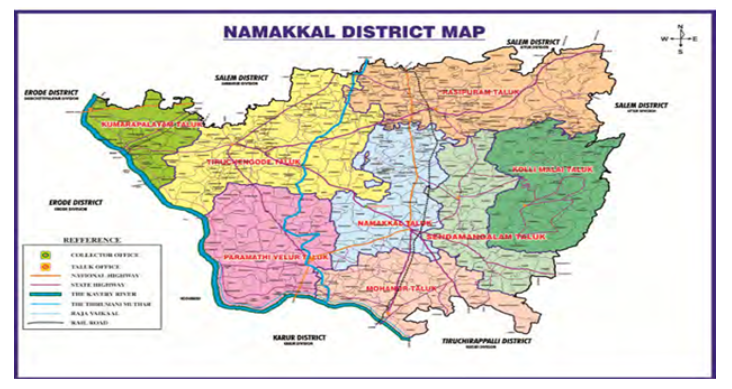
Where to use ?
Paper I ( Geography Optional ) : Regional Planning
Paper II ( Geography Optional) : Resources
Places in news
- Silkyara: Silkyara Bend–Barkot tunnel is a 4.531 kilometer (2.815 mile) long, two-lane, bi-directional tunnel that will connect National Highway 134 in the Uttarkashi district of Uttarakhand, India. The tunnel is part of the Char Dham all-weather accessibility project. (Approx. Uttarkashi )
- Hanle : It is a village in the Leh district of the Indian state of Ladakh. It is home to the Indian Astronomical Observatory, which is home to some of the world's highest major astronomical telescopes. The observatory is known for being an excellent location for visible, infrared, and submillimeter observations. (Approx. Leh )
- Tenkasi : It is a town and the headquarters of the Tenkasi district in the Indian state of Tamil Nadu. It is known for its waterfalls and temples, and is famous for its Courtallam Falls and Kasi Viswanathar Temple. It is known as the Kasi of the South, referring to the Kasiviswanathar temple. The temple is believed to have been built by a Pandyan King, King Arikeari Parakrama. ( Approx. Tirunelveli)
- Singalila National Park : It is a national park in the Darjeeling district of West Bengal, India. The park is located on the Singalila Ridge at an elevation of over 2,300 meters above sea level. It was established in 1986 and is managed by the Government of India.The park is known for the trekking route to Sandakphu that runs through it. ( Approx. Darjeeling )
- Kadavur Slender Loris Sanctuary: The Kadavur Slender Loris Sanctuary is India's first sanctuary for slender lorises. The sanctuary is located in the Karur and Dindigul districts of Tamil Nadu. This is part of the Tamil Nadu government’s on-going efforts towards conservation of endangered and vulnerable species in the state. Approx. ( Dindigul)
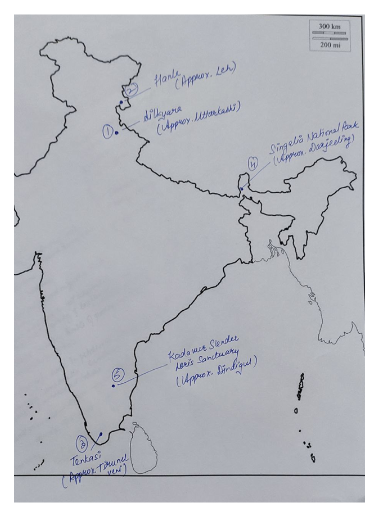
Fortnightly KOSMOS MCQ PRACTICE
Q1. Which of the following releases the Global Food Policy Report?
- World Health Organisation
- Food and Agriculture Organization of the United Nations (FAO)
- International Food Policy Research Institute
- Codex Alimentarius Commission (CAC)
Q2. Consider the following statements:
- Millets are hardy, resilient crops that have a low carbon and water footprint.
- Millets are largely a kharif crop in India.
- Jowar is the largest millet crop grown worldwide.
Which of the above mentioned statements is/are correct ?
- 1 and 3 only
- 1 and 2 only
- 2 and 3 only
- 1, 2 and 3
Q3. With reference to the Mammatus clouds, consider the following statements:
- They typically form alongside big cumulonimbus clouds.
- They are formed in equatorial region only.
Which of the statements given above is/are correct?
- 1 Only
- 2 Only
- Both 1 and 2
- Neither 1 nor 2
Q4. “Fujiwhara Effect” was seen in the news recently. It means –
- "Cyclonic vortices ,where two nearby systems close the distance between their low-pressure circulations."
- The outcome of the chaotic motion of heavenly bodies.
- The outcome brought on by rising atmospheric methane levels.
- The convergence of polar ocean currents close to the equator.
Q5. Consider the following statements:
- The Karakoram Anomaly is the phenomena where the glacier mass in the Karakoram does not diminish.
- It is associated with the "resurgence of Western Disturbances (WDs)" phenomenon.
Which of the statements given above is/are correct?
- 1 Only
- 2 Only
- Both 1 and 2
- Neither 1 nor 2
Q6. Where is Singalila National Park located?
- Odisha
- Assam
- West Bengal
- Bihar
Q7. Consider the following in reference to “Yaya Tso”:
- It is first Biodiversity Heritage Site in Himachal pradesh under the Biodiversity Act.
- It serves as nesting location for birds such the bar-headed goose, blacknecked stork, and Brahminy duck.
- It is one of India's top locations for black-necked stork breeding.
Which of the above mentioned statements is/are correct ?
- 1 and 3 only
- 1 and 2 only
- 2 and 3 only
- 1, 2 and 3
Q8. Which of the following statements with respect to Ken-Betwa river Interlink project, is/are correct?
- It is the first river interlinking project in the country.
- The project's objective is to move extra water from the Betwa river to the Ken River in MP.
Which of the statements given above is/are correct?
- 1 Only
- 2 Only
- Both 1 and 2
- Neither 1 nor 2
Q9. Kadavur Slender Loris Sanctuary is located in:
- Karnataka
- Kerala
- Andhra Pradesh
- Tamil Nadu
Q10. Where is Asola Bhatti Wildlife Sanctuary located?
- Haryana
- Punjab
- Gujarat
- Maharashtra
Share the article
Edukemy’s Current Affairs Quiz is published with multiple choice questions for UPSC exams
MCQ
Get Latest Updates on Offers, Event dates, and free Mentorship sessions.

Get in touch with our Expert Academic Counsellors 👋
Frequently Asked Questions
Geography Current Affairs focuses on the contemporary issues, events, and developments in the field of geography. It covers recent geographical phenomena, environmental changes, geopolitical shifts, and related news. This differs from regular geography studies which may focus more on foundational concepts, historical contexts, and theoretical frameworks.
Updates are provided regularly to ensure that subscribers stay informed about the latest developments in geography. Typically, updates are provided on a fortnightly basis, depending on the frequency of significant events and changes in the field.
Absolutely. Geography Current Affairs serves as a valuable resource not only for Geography optional but also for GS papers, especially GS Paper 1 (covering Indian Heritage and Culture, History, and Geography of the World and Society) and GS Paper 3 (covering Technology, Economic Development, Biodiversity, Environment, Security, and Disaster Management). It aids in building a holistic understanding of various topics and strengthens answer-writing skills by incorporating contemporary examples and perspectives.
Geography Current Affairs holds immense importance for UPSC preparation, particularly for aspirants opting for Geography optional. It helps candidates stay updated with the latest developments, geographical phenomena, environmental issues, and geopolitical shifts worldwide, aligning them with the dynamic nature of the subject as tested in the UPSC examinations.

